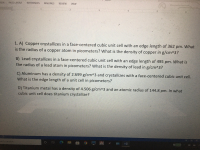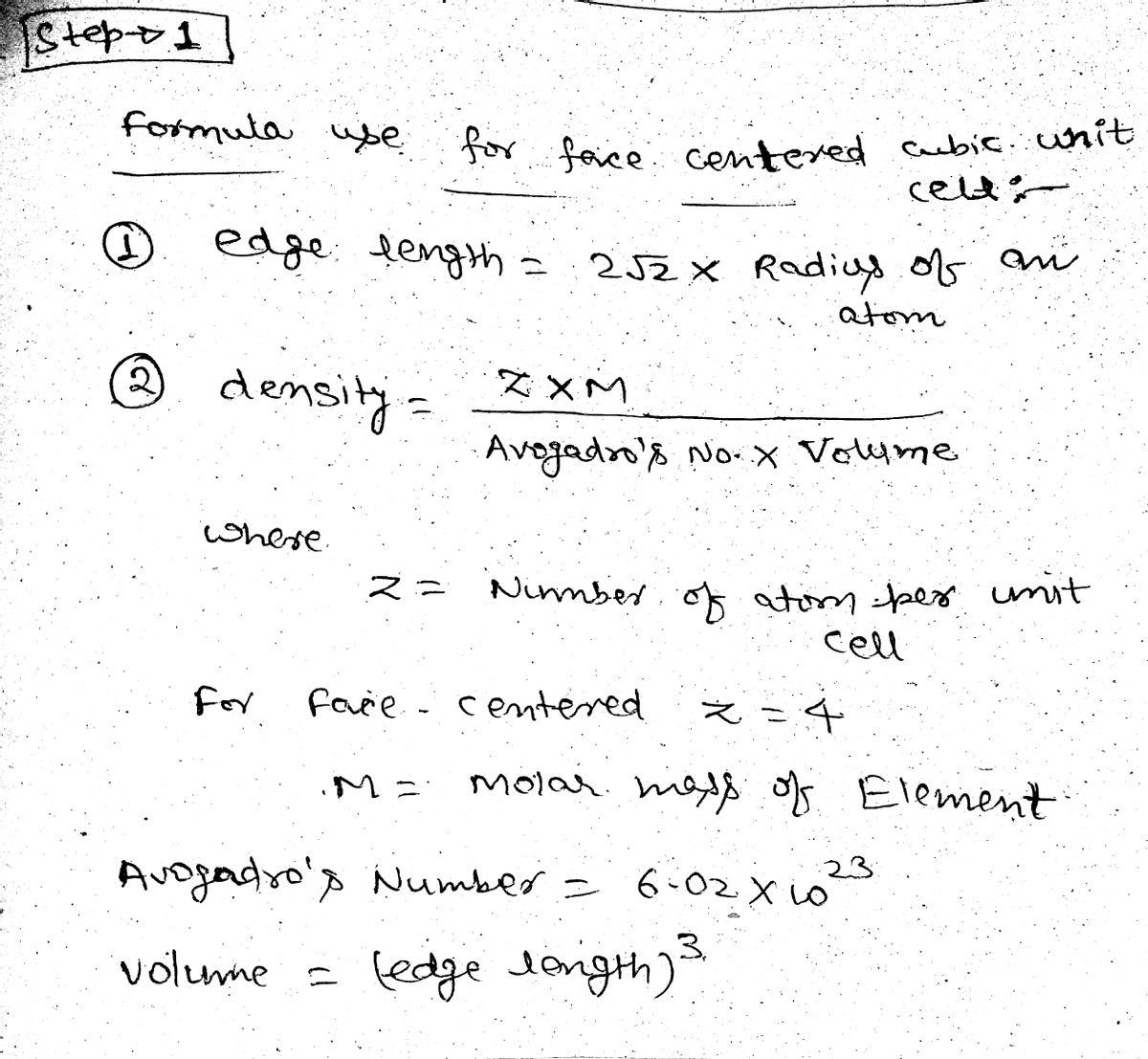
Chemistry
10th Edition
ISBN: 9781305957404
Author: Steven S. Zumdahl, Susan A. Zumdahl, Donald J. DeCoste
Publisher: Cengage Learning
expand_more
expand_more
format_list_bulleted
Question
Can you please solve this sub problems and show the step by step to the solution please and thanks

Expert Solution
arrow_forward
Step 1

Step by stepSolved in 5 steps with 5 images

Knowledge Booster
Learn more about
Need a deep-dive on the concept behind this application? Look no further. Learn more about this topic, chemistry and related others by exploring similar questions and additional content below.Similar questions
- 2. Calculate the [I] (after dilution in the 50.00 mL flasks) for the four standard solutions you make up in part B. Use the data given in Table B and show all calculations. Round your answers to the correct number of significant figures. Record these values on the spreadsheet template before the lab.arrow_forward<- YouTube Maps Netflix in other Co... Nhttps://lms.naz.ed... TO S Question #7 Chelsea the Chemist needs to make 300.0 mL of 2.50 M HNO3 solution. She has 15.0 M (concentrated) HNO3 solution available. Select the correct choices from the drop-down menus to describe how she should make this solution. Combine く of 15.0 M HNO3 with to make 300.0 mL of 2.50 M HNO3 solution. く distilled water Question #8 An ammonium nitrate (NH4NO3) solution is 50.0% NH4NO3 by mass and has a density of 1.22 g/mL at 25°C. What is the molarity of this NH4NO3 solution? (Round your answer to 3 significant figures.) M Question #9 23 98,358 19 JUN 17 2 14 tv♫ NAO X Warrow_forwardStuck need help! Problem is attached. please view attachment before answering. Really struggling with this concept. Please show all work so I can better understand ! Thank you so much.arrow_forward
- Name: Date: Section: Report Sheet: Determination of Molecular Weight Through Freezing Point Depression Analysis 30 Part A: Volume of Cyclohexane mL Mass of cyclohexane (d =0.7786 g/mL) 6.0 °C Freezing Point of cyclohexane 128 Part B: Molecular Weight of Naphthalene g/mol 0.23 Mass of Sample 1 Moles of Sample 1 Mass of Sample 2 0.18 Moles of Sample 2 Moles m (mol/kg solvent) T,('C) AT, Naphthalene 5.1 TRIAL 1 5.3 TRAIL 2 k, Cyclohexane CC/m) Part C: Unknown Number 0.21 0.19 Mass of Sample 1 Mass of Sample 2 Grams Unknown T,('C) AT 0.21 4.8 TRIAL 1 0.19 5.0 TRAIL 2 Moles UnknownTRIAL 1 (moles) TRIAL 2 (moles) TRIAL 1 (g/mol)TRIAL 2 (g/mol) Molecular Weight Unknown (g/mol) AVERAGE MOLECULAR WEIGHT OF UNKNOWNarrow_forwardHow many mL of 0.779 M HNO3 are needed to dissolve 5.15 g of BaCO3? esc 1 F1 AAB 2 Q *** F2 W # 3 80 F3 E $ 4 000 000 F4 2HNO3(aq) + BaCO3(s) Ba(NO3)2(aq) + H₂O(l) + CO₂(g) R Cengage Learning | Cengage Technical Support % er oo 5 F5 MacBook Pro T A 6 F6 & 7 Y F7 mL * DII U F8 8 DO 9 1arrow_forwardBeyond the Course: Your beverage company is branching out from added sugar in their beverages to make a drink where the main ingredient is fresh-squeezed orange juice, called Beverage C. Yum! The beverage will still be subjected to the same taxes as Beverages A & B, so determining sugar content is still vital. Suggest a method of reliably examining the sugar concentration in each batch of Beverage C. Some considerations to address: Do you want to measure the same property for Beverage C as you did for Beverages A & B? ● Can you use the same calibration curve as you did for Beverages A & B? Describe the considerations you made when determining your method.arrow_forward
- help please answer in text form with proper workings and explanation for each and every part and steps with concept and introduction no AI no copy paste remember answer must be in proper format with all workingarrow_forwardDATA AND CALCULATIONS Show all calculations neatly on an attached sheet. Trial 1 Trial 2 Trial 3 70.6849. 68.0749 2.61g 23.25ML O.65ML 22.6mL Mass of flask + vinegar Mass of empty flask Mass of vinegar used Final buret reading Initial buret reading Volume of NaOH used Moles of NaOH used 0.00226 mol Moles of açetic acid titrated Mass of acetic acid titrated Mass % acetic acid in vinegar 5.0%arrow_forwardFor results/conclusions Using the images attached Write 2 paragraphs 1st paragraph: Starts with Objective. Results of DeltaT and i stated 2nd paragraph: sources of errors discussed The objective is The colligative properties are the properties that undergo a change when a solute is introduced to a solvent. Freezing point depression is also a colligative property. The addition of a solute to a solvent reduces the freezing point of the resulting solution. The freezing point of the solution is always lower than the freezing point of the solvent. This difference in the freezing point between solvent and solution is called freezing point depression. The freezing point depression is directly proportional to the molality of the solution or the number of moles of solute present in the solution.arrow_forward
arrow_back_ios
SEE MORE QUESTIONS
arrow_forward_ios
Recommended textbooks for you
 ChemistryChemistryISBN:9781305957404Author:Steven S. Zumdahl, Susan A. Zumdahl, Donald J. DeCostePublisher:Cengage Learning
ChemistryChemistryISBN:9781305957404Author:Steven S. Zumdahl, Susan A. Zumdahl, Donald J. DeCostePublisher:Cengage Learning ChemistryChemistryISBN:9781259911156Author:Raymond Chang Dr., Jason Overby ProfessorPublisher:McGraw-Hill Education
ChemistryChemistryISBN:9781259911156Author:Raymond Chang Dr., Jason Overby ProfessorPublisher:McGraw-Hill Education Principles of Instrumental AnalysisChemistryISBN:9781305577213Author:Douglas A. Skoog, F. James Holler, Stanley R. CrouchPublisher:Cengage Learning
Principles of Instrumental AnalysisChemistryISBN:9781305577213Author:Douglas A. Skoog, F. James Holler, Stanley R. CrouchPublisher:Cengage Learning Organic ChemistryChemistryISBN:9780078021558Author:Janice Gorzynski Smith Dr.Publisher:McGraw-Hill Education
Organic ChemistryChemistryISBN:9780078021558Author:Janice Gorzynski Smith Dr.Publisher:McGraw-Hill Education Chemistry: Principles and ReactionsChemistryISBN:9781305079373Author:William L. Masterton, Cecile N. HurleyPublisher:Cengage Learning
Chemistry: Principles and ReactionsChemistryISBN:9781305079373Author:William L. Masterton, Cecile N. HurleyPublisher:Cengage Learning Elementary Principles of Chemical Processes, Bind...ChemistryISBN:9781118431221Author:Richard M. Felder, Ronald W. Rousseau, Lisa G. BullardPublisher:WILEY
Elementary Principles of Chemical Processes, Bind...ChemistryISBN:9781118431221Author:Richard M. Felder, Ronald W. Rousseau, Lisa G. BullardPublisher:WILEY

Chemistry
Chemistry
ISBN:9781305957404
Author:Steven S. Zumdahl, Susan A. Zumdahl, Donald J. DeCoste
Publisher:Cengage Learning

Chemistry
Chemistry
ISBN:9781259911156
Author:Raymond Chang Dr., Jason Overby Professor
Publisher:McGraw-Hill Education

Principles of Instrumental Analysis
Chemistry
ISBN:9781305577213
Author:Douglas A. Skoog, F. James Holler, Stanley R. Crouch
Publisher:Cengage Learning

Organic Chemistry
Chemistry
ISBN:9780078021558
Author:Janice Gorzynski Smith Dr.
Publisher:McGraw-Hill Education

Chemistry: Principles and Reactions
Chemistry
ISBN:9781305079373
Author:William L. Masterton, Cecile N. Hurley
Publisher:Cengage Learning

Elementary Principles of Chemical Processes, Bind...
Chemistry
ISBN:9781118431221
Author:Richard M. Felder, Ronald W. Rousseau, Lisa G. Bullard
Publisher:WILEY